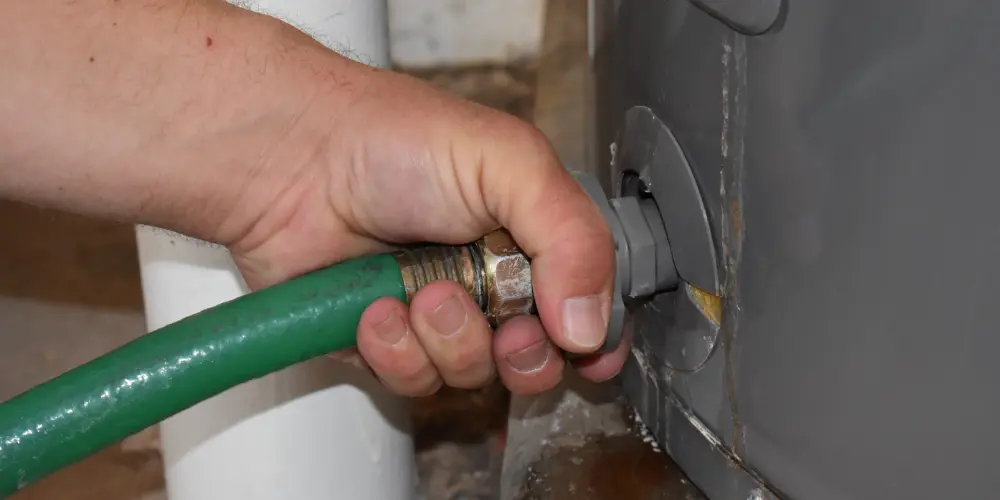Why Water Heater Maintenance Matters
Wim Hof, the famous Dutch iceman, set the record for the farthest under-ice swim at 57.5 meters (188.6 feet). He wore goggles so his corneas wouldn’t freeze.
Wim trains daily with ice baths, but anything under 70F feels chilly for mere mortals. Anything approaching 140F can scald the skin. Wim may not care about water heaters, but the rest of us do.
A reliable water heating appliance is at the core of every invigorating shower or comforting hot bath.
Unlike dishwashers, refrigerators, and ovens, water heaters are usually tucked away in a closet or some dark corner. It’s easy to forget about them until something goes wrong. By then, you may be looking at costly repairs or even replacement.
In a hard water zone like Southern California, neglecting your water heater leads to mineral buildup. It compromises appliance life, efficiency, and your cherished hot water supply. So grab your toolkit, summon some DIY spirit, and follow this step-by-step guide to hot water bliss.
How to Drain Your Water Heater
We recommend you drain and flush your water heater at least once a year. However, depending on the hardness of your local water supply, you might need to do this more often.
So, if you notice any signs of mineral buildup or your hot water supply seems less reliable, it’s likely time for a drain and flush. The flushing process outlined here applies to conventional tanks. Tankless water heaters require a distinct flushing procedure involving specialized kits.
Step 1: Gather Your Tools
- Garden hose (make sure it’s long enough to reach a drain)
- Screwdriver
- Gloves (protect those hands!)
- Safety goggles (better safe than sorry!)
- Adjustable wrench
- Towels or rags (for potential spills)
Safety First!
Allow the water heater to cool before starting. Water straight from the heater can scald.
Step 2: Turn Off the Power & Water Supply
- Turn off the water heater’s power from the breaker box.
- Locate the cold water supply valve connected to your heater, typically atop the heater or along the water inlet pipe. Turn it clockwise to stop the water flow.
Step 3: Drain the Water Heater
- Find the drain valve at the base of your water heater. Attach one end of the garden hose snugly to this valve.
- Position the other end of the hose towards a drain or outside space.
- Open the pressure relief valve (often a lever near the top of the heater) to allow air into the tank. This helps the water flow freely.
- Open the drain valve and let all the water out. The process may take a while, so be patient!
Step 4: Flush the Sediment
- Once the water has drained, close the drain valve tight.
- Remember to shut the pressure relief valve.
- With the drain valve still closed, turn on the cold water supply for a few minutes. This quick burst will flush out any remaining sediment trapped inside.
Step 5: Final Checks
- Turn off the water supply again. Disconnect the hose and ensure all valves are tightly closed.
- Switch on the power to your water heater.
- Slowly turn on the water supply and inspect for leaks around the connections. If everything looks good, you’re in business!
If Drainage Is Slow or Obstructed
If you’re facing slow or obstructed drainage, follow these steps:
- Patience is a virtue: Sometimes, slow drainage is due to a large amount of sediment. Give it some time; the flow might improve on its own.
- Nudge it along: Try dislodging the sediment. Shut off the drain valve, wait a few minutes, then open it again. The rush of water may break through minor blockages.
- Use a plumber’s helper: Bring out the plumber’s snake. Run it gently into the drain valve to break up the sediment, but be careful not to damage the tank.
- When all else fails, call a pro: If you’ve tried everything and the water’s still not flowing, call a professional plumber with the tools and experience to handle stubborn blockages without damaging your water heater.
The Benefits of Regular Flushing
Noise Reduction
Hard mineral deposits knocking around inside your water may cause unsettling rumbling sounds. With the sediment gone, so is the noise.
Energy Savings
Flushing restores heat transfer efficiency. Without those barriers of mineral buildup, the heating element comes in direct contact with water, speeding up the process. It’s like giving your water heater a new lease on life!
Prolonged Appliance Lifespan
Scale accumulation forces the heater to consume more energy. Regular flushing reduces undue stress on the tank, prolonging appliance life.
When Age Becomes a Factor
Gas water heaters typically last 8 to 12. Electric heaters last for about 10.
Consider a replacement if your water heater is nearing the end of its lifespan to save you from a flood in your garage. When searching for a new heater, consider fuel type, storage capacity, and energy efficiency. An energy-efficient model will cost more in the short term, but save money in the long run.
Calling for Professional Help
Orange County, CA, residents and businesses can always count on Orange Coast Plumbing for quality water heater repairs at a fair price.
- We’re dedicated to customer service. We complete every job to the highest standards.
- We’re family-owned and operated, not a franchise with corporate headquarters in another state.
- We back up all work with a 100% satisfaction guarantee.
- We charge by the job, not the hour. There won’t be any surcharges or unpleasant surprises on your bill.
- We hire the best people, not just the best plumbers and HVAC technicians.
- All OCP plumbers and technicians are licensed, certified, and bonded. We do residential, commercial, and industrial work.
- We have the largest service fleet in Orange County, CA, and can answer your call fast. We have dispatch locations throughout the county.
- We have a large team! Each plumber has specialties and strengths, so we’ll always send the best person to handle your repair.
FAQs: Flushing Your Water Heater
Q: How much energy does a water heater use?
A: The water heater accounts for about 17% of the total energy consumption in a typical American home. (DirectEnergy.com)
Q: How often should I drain and flush my water heater?
A: We recommend performing this maintenance task once a year to keep your water heater in top-notch condition.
Q: Is draining and flushing necessary?
A: Absolutely! Sediment buildup can reduce efficiency, increase energy costs, and damage your heater. Regular maintenance extends its lifespan and keeps it running smoothly.
Q: Can I DIY this, or should I call a professional?
A: Flushing is a task you can tackle on your own if you’re comfortable following instructions and handling basic tools. Otherwise, a professional plumber can handle the job fast and inspect your heater to boot.
Q: What are the visible signs of sediment buildup in my water heater?
A: If your hot water has a murky or sandy appearance or your water heater makes rumbling noises, these are possible signs of sediment buildup in your tank.
Q: Should I take any safety precautions while flushing my water heater?
A: Always wear protective gloves and eyewear. Also, remember that the water draining from the tank will be very hot, so be careful to avoid burns.
Q: Can frequent flushing damage my water heater?
A: No, regular flushing won’t damage your water heater. It can prolong the life of your appliance by preventing scale buildup.
Q: How long does it take to flush a water heater?
A: The flushing process typically takes about 30 minutes to 1 hour. However, if you have considerable sediment buildup, it could take longer.
Q: Can I still use my hot water while the water heater is being flushed?
A: No, it’s best not to use hot water during flushing.
Q: Is there a best time of year to flush my water heater?
A: You can flush your water heater any time of year. Many people prefer to do it in the fall before the colder months, when hot water use increases.
Q: What happens if I never flush my water heater?
A: If you never flush your water heater, sediment will accumulate. This buildup can make your heater work harder than necessary, reducing its lifespan and increasing energy costs.
Q: Can flushing my water heater improve the taste of my hot water?
A: If sediment buildup affects the taste of your hot water, flushing your tank can help.
Q: Can flushing improve the color of my hot water?
A: Flushing your water heater can remove minerals that might make your hot water rusty.


